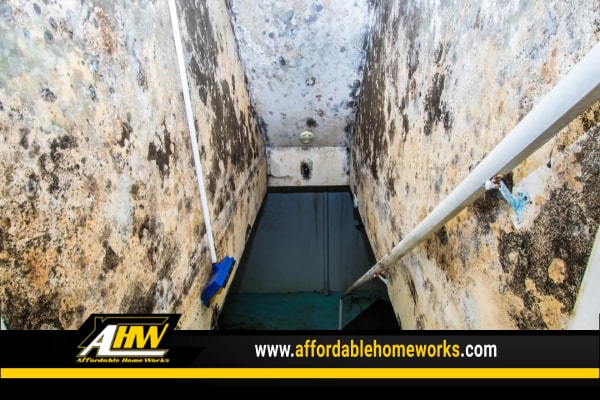
Basement mold can cause serious health problems if left unchecked, so every homeowner needs to understand what causes this type of fungus and how they can prevent it from forming in their homes.
By keeping your basement dry and well-ventilated, inspecting for leaks or cracks regularly, installing a dehumidifier if necessary, and calling a professional if signs or symptoms appear –you can help protect your home from potential harm caused by basement mold growth. Taking these steps now will save you hassle down the line!
What is basement mold?
Every homeowner should be aware of the risks posed by basement mold. This mold can cause a wide range of health problems, so it is important to understand what causes basement mold and how to prevent it from forming. Let’s look closer at basement mold and how you can protect your home from this potentially dangerous fungus.
What causes basement mold?
Basement mold is a serious problem that can affect your home’s air quality and, if left untreated, can cause health problems. Knowing what causes basement mold and how to prevent it will help keep your family safe and healthy. In this blog post, we’ll cover the common causes of basement mold, how to identify it, and what steps you can take to protect your home from this potentially dangerous fungus.
Causes of Mold in the Basement
Mold loves damp, warm environments, making basements the perfect breeding ground for mold. Common causes of basement mold include:
• Poor ventilation
Without good air circulation, moisture is trapped in the basement, leading to ideal mold growth conditions.
• Leaks or flooding
Water leaks or floods can easily seep into the walls or flooring and provide an environment for mold to form.
• High humidity levels
Humidity levels above 50 percent create an ideal environment for molds like Aspergillus and Penicillium to thrive.
• Condensation on pipes or other surfaces
Condensation occurs when warm air comes into contact with cold surfaces, such as pipes or windowsills in the basement. This creates moisture which allows mold to grow quickly.
Identifying Basement Mold
If you suspect a problem with basement mold, there are several signs you should look out for that indicate its presence. These include musty odors; discoloration on walls, floors, or ceilings; visible patches of black or green spots; water stains; peeling paint; allergies such as sneezing, coughing, wheezing, etc.; and headaches after entering the room where the suspected mold is located. If any of these signs are present in your home’s basement space, you must take action immediately before further damage occurs.
What are some signs that I have basement mold?
Mold is a common problem in basements but can be difficult to detect. Knowing what signs to look for can help you take the necessary steps to prevent and remove mold from your basement.
Unpleasant Odors
One of the most common signs of basement mold is an unpleasant musty odor. This odor is caused by microbial activity and usually indicates mold growth in your home. If you notice a pungent smell in your basement, it’s best to investigate further to determine if you have a mold problem.
Visual Clues
Another telltale sign of basement mold is visible growth on walls or other surfaces. Mold can appear as green, gray, brown, or black spots on your walls and ceilings and may be accompanied by discoloration or staining. It’s also important to note that not all mold is visible; some types may hide behind wall coverings or inside ventilation systems.
Health Issues
If you are experiencing health issues such as sneezing, coughing, watery eyes, headaches, or difficulty breathing, it may be due to exposure to mold spores in your home. In addition, people with allergies or asthma may be more sensitive to exposure to mold and should take extra precautions when dealing with potential sources of contamination in their homes.
How can I prevent basement mold?
Whether it’s visible or not, having a moisture-filled environment can lead to serious damage and health risks. Here’s what you can do to help prevent mold in your basement.
1. Improve ventilation.
If you have adequate air circulation, the moisture levels in your basement will decrease. This might mean adding windows or vents to bring fresh air into the space. However, if these options are unavailable, installing an exhaust fan or dehumidifier can help circulate the air and reduce moisture levels.
2. Fix plumbing issues.
Leaky pipes and cracks in walls are common causes of water damage and mold growth in basements, so address any plumbing problems as soon as possible. If you suspect a leak but can’t find it right away, check for signs of discoloration on the walls or ceiling and contact a plumber if necessary.
3. Watch out for condensation buildup.
Condensation occurs when warm air meets cold surfaces like concrete walls or windowsills, leading to excess moisture that can cause mold growth. To prevent this from happening, use insulation whenever possible and keep an eye out for wet spots on windowsills or other surfaces that could indicate condensation buildup.
What should I do if I find basement mold?
A common problem homeowners face is the presence of mold in their basements. While mold can often be unsightly and leave an unpleasant smell, it can also cause serious health problems. So, if you find mold in your basement, what should you do? Let’s take a look at how to handle this issue.
Identify the Mold
The first step is to identify the mold that has grown in your basement. Different types of molds require different remediation techniques, so you must be able to identify what kind you have. If the mold growth is extensive or poses a health risk, consider calling a professional for help with identification and removal.
Remove the Mold
Once you know what type of mold it is, it’s time to start removing it. You should always wear protective gear such as gloves and a mask when dealing with mold growth; this could include goggles and even a respirator depending on the type of mold present. Additionally, open any windows or doors nearby to ensure proper ventilation while you work. Then begin scrubbing down the area with bleach or another appropriate cleaner – follow safety instructions on any products you use! After cleaning up as much of the visible mold as possible, dry out the entire area completely before moving on. This will help prevent further growth in the future.
Replace Damaged Materials
Remove and replace any materials that were too badly damaged by mold growth (such as walls or flooring) if necessary. If doing so yourself isn’t feasible or safe for your skill level, consider hiring a professional contractor specializing in water damage repair. Once everything is replaced and installed properly, make sure to seal all seams with caulk or sealant to prevent moisture from entering again in the future! Eventually, test all areas with a humidity meter (or similar tool) to ensure there aren’t any hidden pockets of moisture where new mold could grow again soon after treatment.
Conclusion
Mold can be an unpleasant surprise for many homeowners – but it doesn’t have to be an insurmountable problem! By identifying the type of mold present and following proper cleaning procedures (including replacing damaged materials), most cases can be handled without needing professional help. In more serious cases, however – or when dealing with particularly toxic molds – seeking help from experts is always advised for the best results and safety reasons! Taking steps to prevent future problems is always better than trying to clean up after them later on – so don’t wait until it’s too late!
